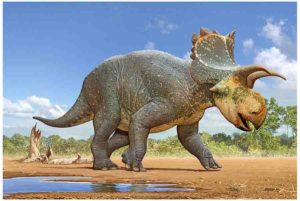
Palentologists are announcing a new dinosaur discovery in the southwest United States. Crittendenceratops krzyzanowskii is a new ceratopsid (horned) dinosaur from 73-million-year-old (Late Cretaceous) rocks in southern Arizona. It is one of the few dinosaurs named from Arizona.
Crittendenceratops krzyzanowskii was named by Sebastian Dalman, John-Paul Hodnett, Asher Lichtig and Spencer Lucas, Ph.D, in an article recently published in the New Mexico Museum of Natural History & Science Bulletin.
Dalman and Lichtig are Research Associates of the New Mexico Museum of Natural History & Science (NMMNHS), Lucas is a curator at NMMNHS, and Hodnett is a paleontologist employed by the Maryland-National Capital Parks Commission.
The name Crittendenceratops is for the Fort Crittenden Formation (the rock formation that yielded the dinosaur fossils) and Greek ceratops, which means horned face. The species name krzyzanowskii is for the late Stan Krzyzanowski, a NMMNHS Research Associate who discovered the bones of the new dinosaur.
Crittendenceratops belongs to a group of horned dinosaurs called the centrosaurs, and can be distinguished from other centrosaurs by the unique shape of the bones in its frill (head shield). Crittendenceratrops was about 11 feet long and weighed an estimated three-quarters of a ton. Like other ceratopsids, Crittendenceratops was a plant eater.
The rocks that yielded the bones were deposited along the margins of a large lake that was present in an area southeast of Tucson, Arizona during the Late Cretaceous.
Reference:
A New Ceratopsid Dinosaur (Centrosaurinae: Nasutoceratopsini) From The Fort Crittenden Formation, Upper Cretaceous (Campanian) Of Arizona. www.researchgate.net/publicati … CAMPANIAN_OF_ARIZONA
Note: The above post is reprinted from materials provided by New Mexico Museum of Natural History & Science.










